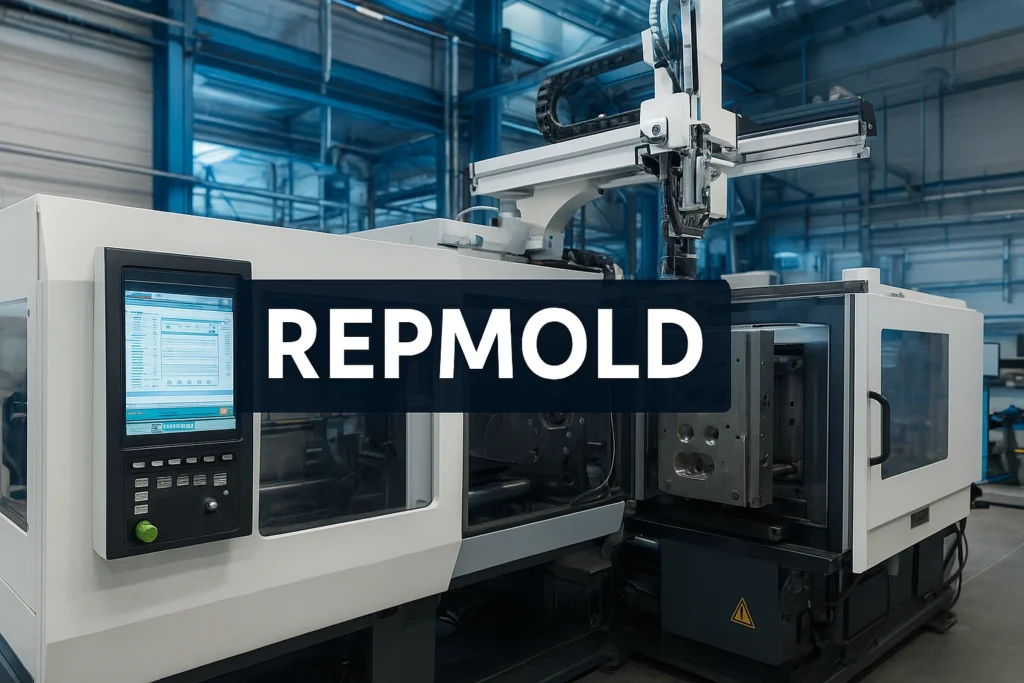In a world where industries are evolving faster than ever, precision and speed have become the ultimate competitive advantage. At the heart of this transformation lies Repmold — a breakthrough approach that’s redefining how molds are designed, produced, and used in modern manufacturing.
Unlike traditional mold-making methods that are slow, expensive, and rigid, Repmold introduces a new era of rapid prototyping, cost efficiency, and sustainability. Whether you’re a manufacturing engineer, product designer, or a business leader exploring advanced production techniques, understanding how Repmold works can give you a strategic edge in the market.
Before exploring how Repmold is reshaping the future of manufacturing, check out our Digital Innovation Blog for more in-depth insights and industry trends.
What Is Repmold and Why It Matters
Repmold is an advanced mold-making process designed to accelerate product development, reduce production costs, and improve design flexibility. Unlike conventional molding, which can take weeks to finalize, Repmold allows manufacturers to create high-quality molds within days — sometimes even hours.
Think of it as a smart bridge between traditional mold manufacturing and next-generation technologies like additive manufacturing, 3D printing, and AI-driven design. This combination not only boosts speed but also ensures unmatched accuracy and repeatability.
What makes this solution stand out is its ability to merge efficiency, sustainability, and scalability — three pillars shaping the future of modern industry.
The Evolution of Mold Making: From Manual to Repmold
For decades, mold making relied on manual craftsmanship and heavy machinery. While effective, it was often expensive and inflexible. Adjustments or redesigns meant restarting entire processes, leading to significant delays.
Repmold changes this narrative. By integrating digital design systems and automated production workflows, it eliminates bottlenecks that once slowed down innovation.
Here’s how Repmold represents a leap forward:
- Faster design-to-production cycles
- Real-time mold iteration without full remanufacturing
- Reduced waste through sustainable material use
- Compatibility with smart factory systems
In short, what once took weeks can now be done in a fraction of the time — without sacrificing quality.
How Repmold Works: A Step-by-Step Breakdown
Understanding the Repmold process helps uncover why it’s becoming a global manufacturing standard. Here’s a simplified overview:
- Digital Mold Design
Engineers start with a CAD model, optimizing for performance and production requirements. - Material Selection
Repmold allows for a variety of durable, cost-effective materials — often lighter and more sustainable than traditional metals. - Automated Mold Creation
The design is transferred to automated machinery or 3D printing systems, enabling precise mold production. - Rapid Testing and Iteration
Unlike traditional molds, this innovative system can be quickly tested and adjusted on the go, speeding up product development cycles. - Production Scaling
Once validated, molds are replicated efficiently to meet production demands.
This streamlined process saves manufacturers both time and resources, offering unparalleled flexibility in product innovation.
Key Benefits of Repmold for Modern Industries
Repmold is more than a new manufacturing method — it’s a strategic advantage. Global companies are increasingly adopting this approach for its measurable impact on productivity and cost reduction.
1. Speed and Agility
This advanced solution shortens lead times, helping businesses launch products to market more quickly.
2. Cost Efficiency
Less waste, lower labor costs, and reduced material usage make this approach a budget-friendly alternative to traditional methods.
3. High Precision and Consistency
The digital-first approach ensures accurate molds with minimal error margins, even across large production runs.
4. Sustainability
By using eco-friendly materials and minimizing waste, this technology actively supports greener manufacturing goals.
5. Scalability
These systems are highly adaptable, whether you’re creating a single prototype or scaling up for mass production.
These benefits explain why industries ranging from automotive and aerospace to medical and consumer electronics are shifting to Repmold-based solutions.
Real-World Applications of Repmold
The impact of Repmold isn’t limited to a single sector. Its flexibility and efficiency have made it a game-changer across multiple industries.
- Automotive Manufacturing: Rapid prototyping of car components and lightweight parts.
- Aerospace: High-precision molds for complex geometries.
- Medical Devices: Fast and sterile mold creation for critical instruments.
- Consumer Goods: Scalable mold systems for fast-moving product lines.
- Industrial Equipment: Durable, long-lasting molds for heavy-duty applications.
For example, many automotive suppliers now use Repmold to shorten their development timelines, ensuring they stay ahead in a competitive market.
To explore how digital tools are reshaping industries, check out our in-depth analysis of Tex9 Net Review 2025: A Smarter Way to Create and Collaborate.
Repmold and Industry 4.0: A Perfect Match
Repmold perfectly aligns with the vision of Industry 4.0, where digital transformation drives smarter manufacturing. By integrating IoT, AI, and real-time data analytics, manufacturers can predict mold performance, optimize designs instantly, and reduce production downtime.
Its capacity to automate repetitive tasks while staying flexible makes this solution a perfect fit for smart factory ecosystems.
If you’re curious about how emerging digital platforms drive innovation, explore our article on Pizmotidxizvou: Blending Tradition With AI Innovation.
Expert Insights and Industry Statistics
- According to World Economic Forum, companies that integrate digital manufacturing solutions like Repmold can reduce production lead times by up to 50%.
- National Institute of Standards and Technology highlights that advanced mold-making techniques improve precision by over 30% compared to conventional methods.
- Industry adoption rates are rising steadily, especially in North America, Europe, and Asia, as companies seek sustainable, efficient, and cost-effective production methods.
These numbers reflect a growing trend: this technology isn’t a niche innovation — it’s becoming an industry standard.
Actionable Tips for Adopting Repmold in Your Business
If your company is considering transitioning to Repmold, here are practical steps to get started:
- Evaluate Current Production Bottlenecks: Identify where traditional mold making slows you down.
- Invest in Digital Infrastructure: CAD software, 3D printing systems, and IoT integration are crucial.
- Start with Small-Scale Prototyping: Run small production tests first to refine the process before scaling up.
- Train Your Team: Equip engineers and operators with the right technical skills tailored to this manufacturing method.
- Collaborate with Experts: Partner with technology providers to ensure smooth implementation.
This phased approach allows businesses to integrate Repmold seamlessly and minimize operational risks.
The Future of Repmold: Beyond Speed and Cost
As technology evolves, so will Repmold. Upcoming innovations point toward:
- AI-generated mold optimization
- Predictive maintenance using real-time data
- Fully autonomous mold production lines
- Integration with circular economy principles for zero waste
This means the technology will not just make manufacturing faster — it will make it smarter, cleaner, and more profitable.
Conclusion
Repmold is more than a technological shift; it’s a strategic transformation that empowers industries to innovate with speed, precision, and sustainability. By combining digital design, automation, and smart manufacturing, it helps businesses stay ahead in an increasingly competitive global market.
Whether you’re a small-scale manufacturer or a global enterprise, adopting this innovative molding solution today can set the foundation for long-term success. The future of manufacturing isn’t just about making products faster — it’s about making them smarter. And Repmold is leading the way.
Explore more on manufacturing innovation and Industry 4.0 in our Emerging Technology Blog Category.
FAQs about Repmold
1. What is Repmold?
Repmold is a modern mold-making method that combines digital design, rapid prototyping, and automated replication. It’s designed to produce molds faster, with greater precision, and with less waste than traditional techniques.
2. How is Repmold different from traditional molding or 3D printing?
Unlike conventional molds that take weeks to tool, Repmold delivers molds in days (or even hours) by replicating a master mold digitally. Compared to 3D printing, It favors consistency and scalability over arbitrary geometries — it focuses on producing multiple identical units with high accuracy.
3. Which industries can benefit most from Repmold?
Repmold is useful in fields that demand precision, speed, or customization. Key industries include automotive, aerospace, medical devices, consumer goods, and electronics. In these sectors, speed, repeatability, and minimal waste matter greatly.
4. Is Repmold suitable for mass production or just prototypes?
Repmold isn’t limited to prototypes — it can support small to medium production runs as well. For extremely high-volume, long-run production, traditional steel molds may still be more cost-effective. However, for many applications, it provides the right mix of adaptable design and strong production performance.
5. What are the limitations or challenges of Repmold?
Some challenges include initial investment cost, maintenance demands, and material limitations. Not all materials or complex designs adapt well to Repmold. Also, molds may wear faster under heavy usage, and skilled staff or proper training is necessary to maintain precision.
6. How can small businesses adopt Repmold effectively?
Small companies can start by applying Repmold for prototyping or small batches before scaling. Using modular setups, combining this technique with traditional methods, and partnering with experienced providers can reduce risk. Training teams and monitoring mold performance help ensure durability and quality.


